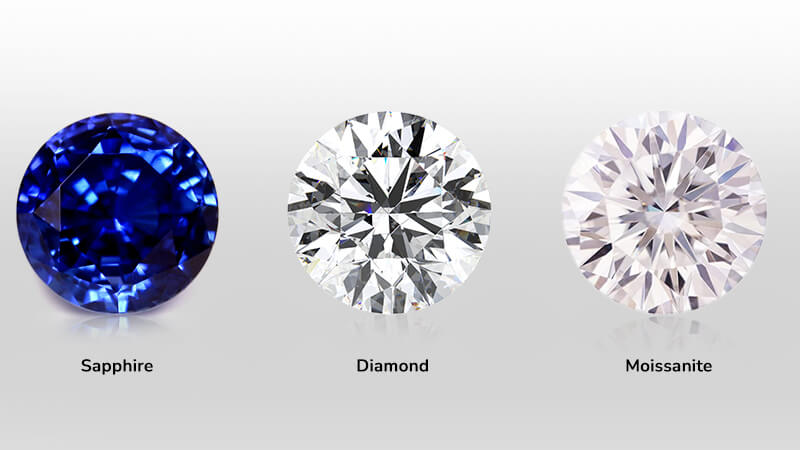Diamonds and white sapphires are two of the most popular gemstones in the world, each possessing its own allure and charm. While they may share some similarities in appearance, they differ significantly in composition, characteristics, and affordability. In this article, we’ll delve into the intricacies of these gemstones to help you understand their differences and make an informed choice for your jewelry needs.
Introduction
Diamonds have long been revered as the epitome of luxury and elegance, renowned for their exceptional brilliance and durability. On the other hand, white sapphires, although less renowned, are gaining popularity as an alternative to diamonds due to their striking resemblance and affordability.
Composition and Characteristics
Diamonds: Carbon Crystalline Structure
Diamonds are composed of carbon atoms arranged in a crystalline structure, resulting in their unparalleled hardness and brilliance. This unique molecular makeup gives diamonds their renowned durability, making them ideal for everyday wear.
White Sapphires: Aluminum Oxide
White sapphires, on the other hand, are a variety of corundum composed of aluminum oxide. While they lack the carbon structure of diamonds, white sapphires exhibit remarkable clarity and brilliance, albeit with slightly less hardness.
Durability and Hardness
Diamonds: The Hardest Substance
One of the key distinctions between diamonds and white sapphires lies in their hardness. Diamonds are the hardest naturally occurring substance on Earth, ranking 10 on the Mohs scale of mineral hardness. This exceptional hardness makes diamonds highly resistant to scratching and abrasion, ensuring their longevity.
White Sapphires: Impressive Hardness
White sapphires, while not as hard as diamonds, still boast impressive hardness, ranking 9 on the Mohs scale. Although slightly less durable than diamonds, white sapphires are still suitable for everyday wear and can withstand the rigors of daily life with proper care.
Brilliance and Sparkle
Diamonds: Unmatched Brilliance
One of the most coveted attributes of diamonds is their unparalleled brilliance and sparkle. Thanks to their high refractive index and exceptional light dispersion, diamonds exhibit a dazzling play of light that captivates the eye and adds to their allure.
White Sapphires: Subtle Elegance
While white sapphires may not possess the same level of brilliance as diamonds, they still exhibit a beautiful sparkle that lends an air of elegance to any piece of jewelry. Their subtle shimmer makes them an attractive choice for those seeking understated sophistication.
Color and Clarity
Diamonds: Dazzling Color Variations
Diamonds come in a wide array of colors, ranging from colorless to fancy vivid hues such as blue, pink, and yellow. The presence of trace elements and structural imperfections determines a diamond’s color and clarity, with colorless diamonds being the most prized for their purity and brilliance.
White Sapphires: Crystal Clear Beauty
White sapphires, as the name suggests, are prized for their crystal-clear appearance and lack of color. While they may not exhibit the vibrant hues of colored sapphires, white sapphires possess a pristine beauty that complements any setting.
Cost and Affordability
Diamonds: Premium Price Tag
As one of the most sought-after gemstones, diamond vs white sapphire a premium price tag commensurate with their rarity and desirability. The cost of diamonds can vary significantly depending on factors such as carat weight, cut, color, and clarity, with larger, flawless diamonds fetching the highest prices.
White Sapphires: Budget-Friendly Alternative
In contrast, white sapphires offer a more affordable alternative to diamonds without compromising on beauty or elegance. Due to their abundance and lower demand relative to diamonds, white sapphires are available at a fraction of the cost, making them an attractive option for budget-conscious consumers.
Ethical Considerations
Diamonds: Ethical Concerns
The diamond industry has faced scrutiny in recent years due to concerns surrounding ethical sourcing practices, particularly in regions where labor exploitation and environmental degradation are prevalent. As a result, many consumers are opting for ethically sourced or lab-grown diamonds to minimize their impact on communities and the environment.
White Sapphires: Ethically Sound Option
White sapphires, being a naturally occurring mineral, are generally considered a more ethically sound option compared to diamonds. While ethical considerations may still arise regarding mining practices and labor conditions in some regions, white sapphires are generally perceived as a more sustainable choice.
Cultural and Symbolic Significance
Diamonds: Symbol of Love and Commitment
Throughout history, diamonds have been revered as symbols of love, purity, and commitment. From engagement rings to heirloom jewelry, diamonds hold significant cultural and sentimental value, representing enduring love and timeless elegance.
White Sapphires: Symbol of Clarity and Wisdom
White sapphires, with their crystal-clear appearance, symbolize clarity, wisdom, and sincerity. While they may not carry the same romantic connotations as diamonds, white sapphires are valued for their purity and simplicity, making them meaningful gifts for special occasions.
Usage in Jewelry
Diamonds: Versatile Gemstone
Diamonds are highly versatile gemstones that can be fashioned into a wide variety of jewelry styles, lab created diamonds, from classic solitaire rings to intricate pendant necklaces and dazzling earrings. Their durability and brilliance make them a popular choice for engagement rings and formal jewelry pieces.
White Sapphires: Timeless Elegance
Similarly, white sapphires are prized for their timeless elegance and versatility in jewelry design. Whether set in platinum, gold, or silver, white sapphires exude a classic beauty that complements both casual and formal attire, making them a popular choice for everyday wear.
Maintenance and Care
Diamonds: Minimal Maintenance
Diamonds require minimal maintenance to keep them looking their best. Regular cleaning with a soft brush and mild detergent solution can help remove dirt and oil buildup, restoring their brilliance and sparkle. Additionally, periodic professional cleanings and inspections ensure that diamonds remain in pristine condition for years to come.
